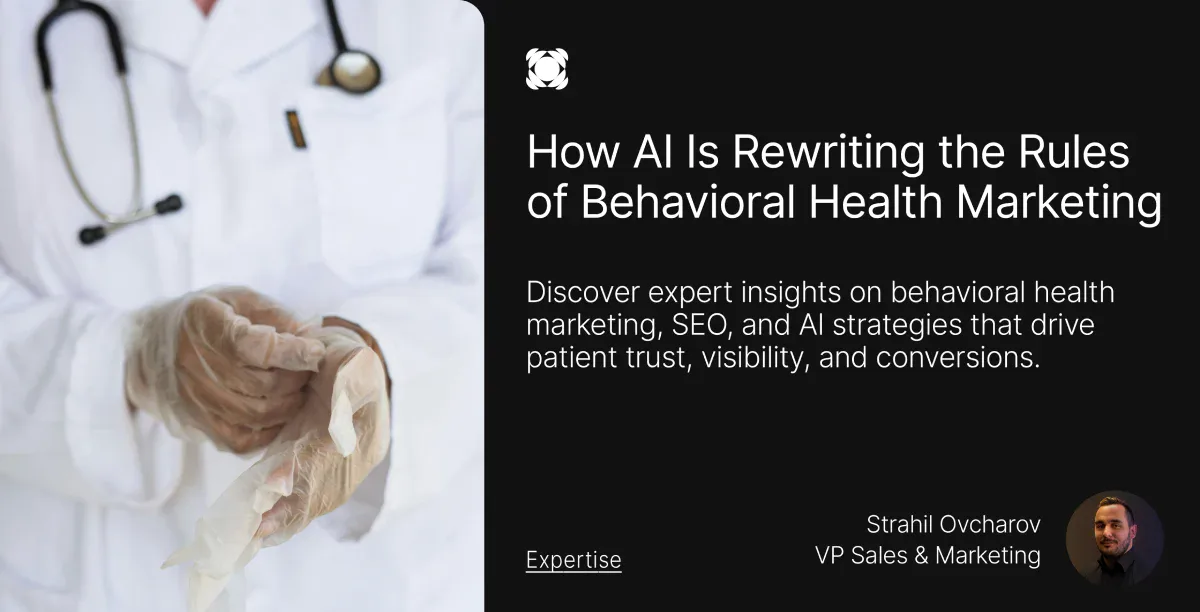Digital growth in behavioral healthcare is no longer about ranking for keywords; it’s about trust, credibility, and meaningful patient journeys. When someone searches for “therapy near me” or “help with burnout,” the organization that wins is not just the one with optimized metadata; it’s the one that inspires confidence before a single click.
During our recent SEO and UX audit with Valera Health, a leading telehealth and behavioral care provider, we uncovered a number of insights that illustrate what it takes to build a high-performing, patient-first digital presence in today’s AI-driven ecosystem.
1. Technical SEO Isn’t the Challenge
Valera Health’s website is an excellent technical performer. From Core Web Vitals to page-load speed, the site outpaces nearly all its competitors. “Page performance, we have no concerns,” we noted during our review. “In fact, you’re clearly ahead of the competition there.”
But the real question for behavioral health marketers isn’t just, “Is my site fast?” Does it convert anxious, searching visitors into confident patients?
When we analyzed Valera’s analytics, the data looked too good; specifically, an unusually low bounce rate and high engagement rate. “Whenever we see super-low bounce but room to grow in conversion, something doesn’t add up,” we told the team. The likely cause? An event-tracking script firing incorrectly, inflating user engagement metrics.
This is more than a data issue; it’s a strategic blind spot. In healthcare, accurate analytics are the foundation for growth decisions. If event data misfires, teams could wrongly conclude that their UX and content are performing better than they actually are.

Clean tracking ensures every optimization dollar moves the needle toward real outcomes, more qualified leads, more appointment requests, and more patients in care.
Takeaway: A fast website is only as valuable as the conversions it creates. Before scaling, validate your analytics and map every metric to patient intent.
2. Metadata Gaps Are Costing Behavioral Health Brands Visibility
When we performed a technical audit of Valera Health’s website, one of the biggest surprises wasn’t poor structure; it was missing metadata. “You’re missing meta titles and descriptions across the entirety of the website,” we told them. “That’s 101 SEO. You’ve got to have it for every single page.”
For context, metadata, including meta titles, meta descriptions, alt tags, and header hierarchies (H1-H3), tells both Google and AI search engines what a page is about. Without it, Valera’s site was effectively speaking to users in a whisper while competitors were shouting their relevance loud and clear.
Behavioral health brands often focus heavily on compliant language, tone, and empathy, all essential, but neglect the structural backbone that helps algorithms understand context. Metadata is the connective tissue between a provider’s expertise and the patient’s search intent.
For Valera Health, aligning metadata with 40-50 targeted keywords, combining therapy types (CBT, telepsychiatry, anxiety therapy), and geographic focus areas (New Hampshire, New York, Vermont) would significantly expand its organic footprint.
Takeaway: Metadata is the language search engines and AI use to understand care offerings. Without it, even the best messages remain invisible.
3. SEO is Evolving into Generative Engine Optimization (GEO)
Search is changing. Patients no longer rely solely on Google; they ask ChatGPT, Gemini, and Perplexity for provider recommendations. This new phase, what we call Generative Engine Optimization (GEO), blends traditional SEO with the mechanics of AI discovery.
“All of your work right now in SEO is also to boost referral traffic coming from the ChatGPTs of the world,” we explained to the Valera team. “That traffic is smaller today, but it’s higher in conversion.”
Valera’s visibility dips coincided with Google’s core algorithm updates, a sign of outdated metadata and potentially AI-generated content that lacked an authentic human voice. “We went m-dash hunting on some of your content,” we said. “It looked like a mix of human and AI writing. That could be damaging to your visibility.”
To compete in the age of GEO, healthcare providers must structure their websites for both humans and algorithms. That means:
Implementing advanced schema markup (FAQ, organization, service, and local schema) so that AI can interpret context and intent.
Updating the robots.txt file to invite AI crawlers.
Maintaining strict H1-to-H3 hierarchies, as AI models prioritize narrative sequence over keyword density.
These updates aren’t just technical niceties; they’re how behavioral health brands ensure AI understands who they are and why patients should trust them.
Takeaway: Generative engines reward structured, authentic expertise. Schema and content hierarchy are now non-negotiable.
4. Building Patient Trust Through Authorship and E-E-A-T
In behavioral healthcare, credibility is everything. Patients don’t just want to find a therapist; they want to find someone they can trust.
One of Valera Health’s most significant missed opportunities was in authorship and trust signals. “When we create blog posts,” we told them, “we need to tell the search engine that this person is a trustworthy expert. I do that with author bio pages.”
Author profiles with photos, credentials, and links to professional pages (LinkedIn, Psychology Today, or institutional bios) communicate legitimacy to both humans and search engines. This aligns with Google’s E-E-A-T framework: Experience, Expertise, Authoritativeness, and Trustworthiness, which heavily influence health content rankings.
We also recommend embedding FAQs, citations to clinical studies, and links to reputable psychology journals within articles. These elements not only elevate search visibility but also reassure patients that the content comes from qualified, compassionate professionals.
Takeaway: Behavioral health SEO isn’t just about optimization; it’s about proving credibility. Every article should showcase the humans behind the healing.
5. User Experience (UX) Defines Patient Conversion
A technically perfect site can still fail if it doesn’t emotionally resonate or guide patients effectively. In Valera’s case, the UX presented unnecessary friction. The “Find Care” navigation took users directly to a multi-step conversion form, a leap too soon for someone still evaluating options.
“The navigation’s a little confusing,” we pointed out. “Find Care goes straight into a complex conversion flow, while Care For You functions more like a service page.”

Behavioral health users often arrive in moments of distress. The design must anticipate hesitation, not amplify it.
The optimal behavioral health service page should follow a long-scroll, story-driven format optimized for mobile, including:
- Compassionate imagery of care interactions.
- Clear explanation of therapy processes and insurance options.
- Testimonials or patient stories that validate outcomes.
- Introductions to clinicians and care teams.
- FAQs addressing privacy, scheduling, and payment.
- Two clear CTAs: a short “Request Appointment” form and a click-to-call option for immediate help.
We also advised expanding into geo-specific landing pages, such as Teletherapy in Vermont or Virtual Counseling in New Hampshire, allowing Valera to dominate local search intent while maintaining national brand recognition.
Takeaway: In behavioral health, UX is empathy in action. Design every page to reassure, inform, and gently convert.
6. Creating Topical Authority Around Conditions and Services
Content is the lifeblood of modern SEO, but not all content moves patients closer to care. Valera’s blog had a strong reach but lacked focus on the conditions and services core to its business.
“These are general search terms that don’t necessarily indicate user intent,” we explained. “They’re a step away from what you actually do.”
The shift needed was from educational content (“Why burnout happens”) to intent-driven content (“Therapy for workplace burnout in New Hampshire”). By organizing posts into content clusters, each centered around a service area (e.g., depression therapy, couples counseling, ADHD management), Valera could build what Google recognizes as topical authority.
We also encouraged adding data-rich visuals, internal cross-links to service pages, and conversion touchpoints in every blog. That ensures content educates and directs action, turning awareness into appointments.
Takeaway: Build content around what you treat, not just what you know. Intent-driven clusters turn thought leadership into measurable growth.
From Digital Presence to Digital Authority
Valera Health exemplifies what many fast-growing telehealth providers experience: a strong brand mission, solid technical execution, and an underutilized SEO strategy. Their website is fast, their content is empathetic, and their team is data-driven. The opportunity now lies in connecting those strengths into a system that scales trust and visibility simultaneously.
SEO for behavioral health is no longer a technical checklist; it’s a strategy of empathy, structure, and expertise. It’s how providers like Valera can reach people when they need help most, using digital tools to deliver human connection.
As we said during our session: “We can do everything here to drive more traffic, but I’m not certain the UX of the website is set up to convert that traffic today.” The same could be said for much of the behavioral health industry.
The path forward is clear:
- Audit and validate analytics to measure real behavior.
- Rebuild metadata and schema for both Google and AI engines.
- Humanize content through authorship and credible expertise.
- Design empathetic user experiences that remove friction from the care journey.
- Earn authority off-site through citations and partnerships.
Behavioral healthcare deserves digital strategies as sophisticated and as compassionate as the care they deliver.









